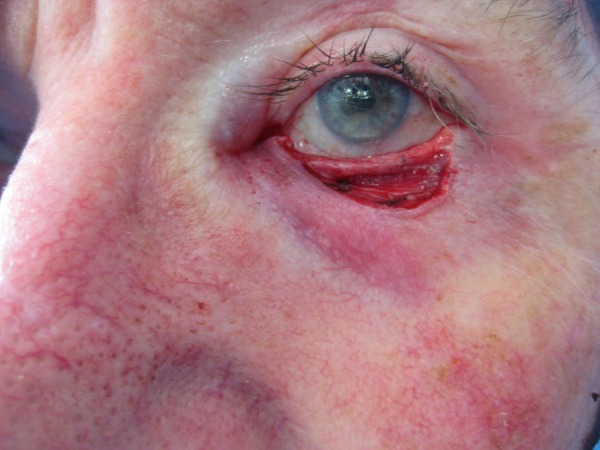Abstract
We present a case of an 84-year-old man with advanced glaucoma on multiple unilateral glaucoma medication. He had 2 years history of unilateral ocular irritation thought to be related to his medication. Patient was referred to an oculoplastic clinic and found to have segmental eyelash loss partially masked by hypertrichosis caused by glaucoma medications. His symptoms were initially thought to be related to drop-induced blepharitis. A clinical diagnosis of possible basal cell carcinoma (BCC) was made and the incisional biopsy showed infiltrative micronodular BCC. The patient underwent Mohs micrographic surgery and eyelid reconstruction with a Hughes flap and full thickness skin graft. Timely diagnosis of BCC requires a high index of suspicion, particularly when the signs are subtle.
Background
Basal cell carcinoma (BCC) is the most common periocular malignancy. It is a slow-growing, locally invasive tumour which arises from the basal cells of the epidermis. BCC can present as an asymptomatic papule with possible ulceration and bleeding, distortion of eyelid margin, loss of eyelashes (madarosis), whitening of eyelashes (poliosis), and abnormal texture or colour of skin. Owing to the variability in presentation, it might be clinically misdiagnosed, which leads to delay in treatment and increased morbidity.
We present a case of BCC with delayed diagnosis due to ocular comorbidity.
Case presentation
History
An 84-year-old man with a 2-year history of left eye irritation was referred to the oculoplastics clinic for possible intermittent left lower lid involutional entropion. His ocular history included bilateral pseudoexfoliative glaucoma, right trabeculectomy augmented with mitomycin C, left failed trabeculectomy, left pseudophakia and dry age related macular degeneration (AMD) with left macular atrophy. The left intraocular pressure was controlled with bimatoprost/timolol and brinzolamide. Owing to the unilateral use of these drops, his symptoms were attributed to antiglaucoma medications.
Past medical history
Skin BCC, hypertension and hypercholesterolaemia.
Examination
Visual acuity: OD 6/7.5 OS 6/15
Adnexa: Hypertrichosis upper and lower lid left eye, with area of patchy loss of lashes and scales on skin of left lower lid (figure 1)
Figure 1.

Focal segmental madarosis in the left lower lid and left hypertrichosis.
Intraocular pressure: OD 13 OS 18
Anterior segment: Formed bleb OD, flat bleb, pseudophakia OS
Fundus: Dry AMD
Investigations
The patient was listed for incisional biopsy of the left lower lid; histopathology showed micronodular BCC.
Differential diagnosis
Chronic blepharitis secondary to prostaglandin use.
Variable hypertrichosis due to topical prostaglandin usage.
Possible morpheaform BCC.
Treatment
Removal of the tumour using Mohs micrographic surgery (figure 2).
Reconstruction of the eyelid defect with a Hughes flap and full thickness skin graft harvested from the right upper lid (figure 3).
Division of Hughes flap (figure 4).
Figure 2.

Removal of basal cell carcinoma with a safety margin.
Figure 3.

Reconstruction of eyelid defect with a Hughes flap and full thickness skin graft.
Figure 4.

Follow-up after division of Hughes flap.
Outcome and follow-up
The patient was reviewed following division of Hughes flap; he had no symptoms and good eyelid position.
Discussion
Early diagnosis and treatment of eyelid BCC results in better functional and cosmetic outcomes. However, the diagnosis can be delayed particularly in morpheaform BCC unless the subtle signs are looked for. Indeed, morpheaform BCC can present with vague symptoms and very subtle signs including ocular discomfort, a scaly plaque with indistinct borders that rarely ulcerates without a clinically apparent mass or just madarosis.
Three clinical features are most consistently associated with BCC:
Madarosis,
Ulceration,
Infiltration and destruction of normal anatomy.1
In this case, madarosis with the only sign that led to diagnosis, although it has many local causes (blepharitis) and systemic causes as chemotherapy, alopecia, nutritional defect, eczema and infections;2 if unilateral, focal or unexplained, it should be treated with suspicion and dermatological malignancy needs to be excluded.
The diagnosis of BCC in our case was difficult due to the unilateral use of bimatoprost (left eye), which was thought to be the reason behind the eyelid changes and patient's symptoms also partly masking madarosis.
Bimatoprost is a prostaglandin F2-α analogue; it has been shown to induce cutaneous hypertrichosis by inducing anagen (growth phase) in resting hair follicles and prolonging anagen in active hair follicles which result in elongation, darkening and increase in the number of lashes.3
Histological confirmation is crucial before performing extensive surgery. Incisional and punch biopsy techniques have relatively high accuracy rates. Incisional techniques have, however, proved more accurate than punch biopsies in identifying the true nature of a tumour in a retrospective analysis of patients who have undergone initial biopsy and subsequent excision of lid tumours between 1994 and 2000 by Rice et al.4
Learning points.
Basal cell carcinoma (BCC) can present with subtle signs and masquerade as blepharitis.
Incisional biopsy is more accurate compared with punch biopsy in diagnosing BCC.
Hughes flap and full thickness skin graft is one of the options for reconstruction of large full thickness lower eyelid defects.
Footnotes
Contributors: AH was involved in the literature review and preparation of the manuscript and also assisted in surgical intervention. DC supervised the submission and performed the surgery.
Competing interests: None declared.
Patient consent: Obtained.
Provenance and peer review: Not commissioned; externally peer reviewed.
References
- 1.Shields CL. Basal cell carcinoma of the eyelids. Int Ophthalmol Clin 1993;33:1–4. 10.1097/00004397-199303330-00002 [DOI] [PubMed] [Google Scholar]
- 2.Kumar A, Karthikeyan K. Madarosis: a marker of many maladies. Int J Trichol 2012;4:3–18. 10.4103/0974-7753.96079 [DOI] [PMC free article] [PubMed] [Google Scholar]
- 3.Choi YM, Diehl J, Levins PC. Promising alternative clinical uses of prostaglandin F2α analogs: beyond the eyelashes. J Am Acad Dermatol 2015;72:712–16. 10.1016/j.jaad.2014.10.012 [DOI] [PubMed] [Google Scholar]
- 4.Rice JC, Zaragoza P, Waheed K et al. Efficacy of incisional vs punch biopsy in the histological diagnosis of periocular skin tumours. Eye (Lond) 2003;17:478–81. 10.1038/sj.eye.6700383 [DOI] [PubMed] [Google Scholar]


